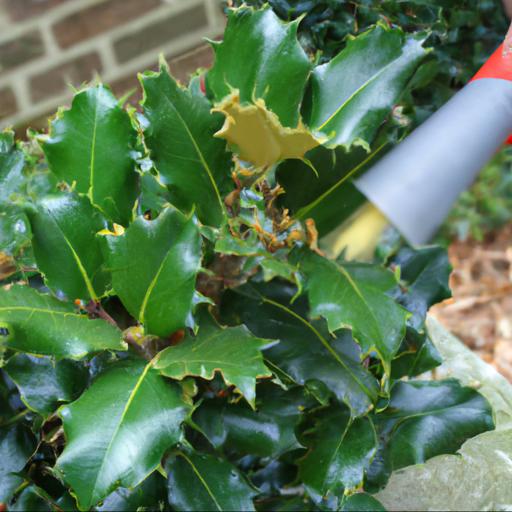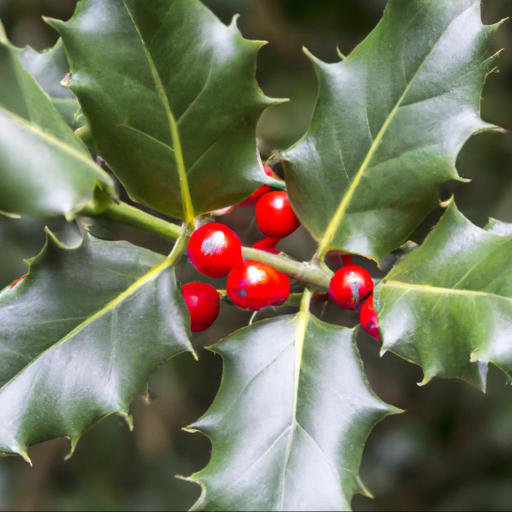Ilex aquifolium, commonly known as holly, is an evergreen shrub or small tree native to much of Europe and western Asia. This species is often grown as an ornamental in gardens and parks, and its glossy, spiny leaves and bright red berries provide a cheerful winter display.
Ilex aquifolium is also an important species in traditional medicine and has been used for centuries to treat a variety of ailments. In this blog, we will explore the many uses of Ilex aquifolium, its unique characteristics, and how to grow and care for this beautiful shrub.
Benefits of ilex aquifolium

The Ilex aquifolium, commonly known as holly, is a species of holly grown in many countries around the world. Native to parts of Europe, North America, and Asia, holly is a woody, evergreen shrub with glossy, dark foliage and bright red berries.
It’s one of the most popular holiday plants and often used to adorn doorways and windows. Beyond its holiday décor benefits, holly has many practical uses in the garden. As an evergreen, holly provides year-round interest with its dark green foliage that is said to turn almost black in the winter with its colorful red berries.
It can be used to create a backdrop for other plants or to form a screen or hedge to provide added privacy. And when planted in a sunny spot, holly can contribute to the beauty of a yard for years to come.
But the benefits of this versatile shrub don’t stop there. Holly berries are toxic to humans but are favored by birds, even during the coldest months of winter. This makes it an ideal choice for bird enthusiasts who appreciate its attractive foliage, everbloom quality and the fact that it has the potential to attract valuable birds such as robins, thrushes and cardinals to their gardens.
In terms of maintenance, holly requires minimal care and attention. Generally, the plant is hardy and slow-growing, and once established will tolerate a range of soils and pH levels.
In the right location, it can be relatively disease and pest-free with the occasional pruning to keep it in shape and tidy. Overall, the Ilex aquifolium is a great option for outdoor spaces looking for a strong, evergreen shrub with year-round interest that can provide privacy, attract wildlife and improve garden settings. It’s a low maintenance plant that is sure to bring lasting value and enjoyment for many years to come.
Growing and caring for ilex aquifolium

. Ilex aquifolium, the holly bush, is a species of evergreen shrub and tree native to Europe, western Asia and North Africa. These broadleaf evergreen plants have attractive and prickly leaves, making them ideal for both hedging and topiary.
At maturity, plants can reach between 5-12 meters in height, though dwarf varieties of about 2 meters can also be found. The lush, dark green leaves of Ilex aquifolium are their most striking feature.
These leathery, waxy leaves can last year-round, even in cold climates. While many of the leaves grow all the way around the stems in a flat, round or oval shape, some varieties of holly will bear leaves with saw-toothed edges, giving them an even more striking appearance. The male and female flowers usually bloom in the spring.
The male flower is small and green while the female flowers are bigger and white. After pollination of the female flowers, small and shiny red berries will appear in autumn, providing a striking seasonal color contrast that can bring your garden to life.
Caring for Ilex aquifolium is relatively easy. A well-draining soil is ideal, although the shrubs are quite tolerant of soil type – from clay and sand to loam. As far as water requirements, regular and thorough watering is preferred, but an occasional deep soak will help if your area is experiencing a hot, dry summer.
Speaking of summer, Ilex aquifolium does well in a full sun environment, but can also tolerate partial shade quite well. Prune the shrubs in late spring or early summer, removing damaged, diseased or dead wood to encourage healthy foliage and maintain a neat, tidy appearance.
If you’re growing Ilex aquifolium as part of a hedge, trim one to two times a year to keep it evenly shaped.
Common uses of ilex aquifolium

Ilex aquifolium, otherwise known as holly, has been a popular evergreen shrub for centuries and holds a special place in folk tradition. Known for its sharp and spiky leaves, deep dark green color and vivid red berries in the late fall, it’s a staple of winter holiday decorations.
But there’s a lot more to this small shrub than just its festive looks—from edible uses to medicinal remedies, this hardy evergreen has a lot to offer throughout the year. Ilex aquifolium is a versatile shrub that can be planted as a specimen plant in a garden, grown in a hedge, or kept as a topiary. Its dense foliage provides ground cover in shady spots, making it an excellent choice for a low-maintenance ground cover plant.
And when grown as a hedge, it makes a great privacy screen for patios or gardens, providing dense evergreen foliage that blocks out wind and reduces noise. Aside from being an attractive addition to the landscape, Ilex aquifolium does have edible and medicinal uses. The holly berries, although not particularly tasty for humans, are an important food source for birds.
The berries can also be used to make an herbal tea noted for its calming effects. And around the world, holly has been used for various folk remedies, including as an antiseptic, astringent, and tonic to aid in digestion.
In conclusion, Ilex aquifolium, or holly, is more than just a traditional holiday decoration. From garden accents to edible berries, this hardy evergreen has a number of benefits that can be enjoyed throughout the year. So don’t forget to consider holly the next time you’re looking for a hardy, low-maintenance evergreen accent for your garden.
Interesting facts about ilex aquifolium
In recent years, Ilex aquifolium, otherwise known as the common holly, has become an increasingly popular garden shrub and ornamental in the UK. Also known as the European or English holly, this evergreen shrub has distinctive pointy leaves and produces small clusters of red berries in the winter, creating a vibrant splash of colour while the rest of the garden is mostly barren. A hardy species, Ilex aquifolium is ideal for any size garden and can be grown in pots or containers, making it a practical and aesthetically pleasing addition to any outdoor space.
As a garden expert for the UK, I can state that Ilex aquifolium thrives in sunny spots, growing well in partial shade. While the species is evergreen, it can sometimes lose its leaves in snowy and icy winters, so it is best to plan for this when selecting a spot for a holly bush.
Furthermore, when selecting an Ilex aquifolium for the garden, it is advised to pick a slow-growing variety as these will require less pruning and can be kept in a neat and structured shape with little effort. Finally, it is worth noting that while Ilex aquifolium is a very attractive garden shrub, it should be handled with care due to its sap which can be irritating to the skin, eyes and mouth.
In addition, holly berries are highly toxic to humans and should be kept away from children and pets. Despite the necessary precautions, Ilex aquifolium remains an ideal garden plant and its bright colours never fail to impress.
Our video recommendation
Bottom Line
Ilex aquifolium, commonly known as holly, is a species of holly native to Europe, western and central Asia, and northwest Africa. It is an evergreen shrub or small tree growing to 10–15 m tall, with smooth grey bark and spiny leaves.
The flowers are white, and the berries are red and poisonous to humans. Ilex aquifolium has been cultivated for centuries as an ornamental plant, and is a popular choice for hedges and topiary. It is also a popular choice for Christmas decorations due to its bright red berries.
FAQ
What is the scientific name of Ilex aquifolium?
The scientific name of Ilex aquifolium is Ilex aquifolium.
What are the medicinal uses of Ilex aquifolium?
Ilex aquifolium, commonly known as holly, has a variety of medicinal uses. It is used to treat digestive issues, such as indigestion and constipation, as well as to reduce inflammation and boost the immune system. It is also used to treat respiratory conditions, such as bronchitis and asthma, and to reduce fever. Additionally, it is used to treat skin conditions, such as eczema, and to reduce pain and swelling.
What is the traditional use of Ilex aquifolium?
The traditional use of Ilex aquifolium is as a medicinal plant. It has been used to treat a variety of ailments, such as colds, headaches, and digestive issues. It has also been used as a tonic and to stimulate the appetite.
What is the distribution range of Ilex aquifolium?
The distribution range of Ilex aquifolium is from western and central Europe, east to the Caucasus, and south to the Mediterranean, North Africa, and the Canary Islands.
What are the common names of Ilex aquifolium?
The common names of Ilex aquifolium are English holly, European holly, and common holly.
What are the chemical constituents of Ilex aquifolium?
The chemical constituents of Ilex aquifolium include flavonoids, tannins, saponins, phenolic acids, and triterpenes.

